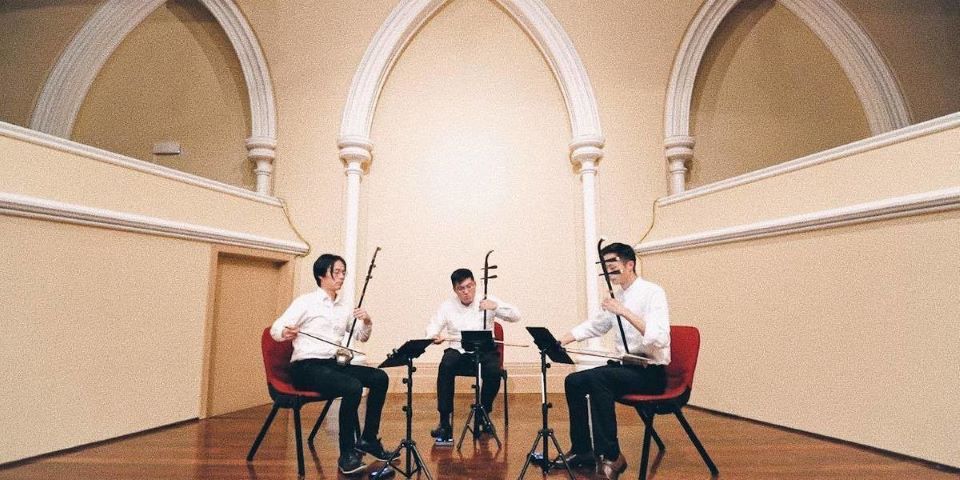[MUSIC – SA, Premiere]
Pilgrim Uniting Church, Sun 3 Mar.
That different cultures across the world have found their own solutions to life’s matters is a fascinating aspect of humanity. Cultures develop distinct ways of dressing, different foods, types of housing, and music. The sitar is the unmistakable sound of India; the Middle East gave us the oud. When you hear that haunting melancholy tone of the erhu you recognise it immediately as Chinese. The erhu is a two-stringed bowed instrument that has a small sound box at its base that is covered with python skin. And according to Wikipedia “its characteristic sound is produced through the vibration of the python skin by bowing.”
Silk Strings are an Adelaide based group of Chinese musicians whose mission is in part to make the music known as huquin more accessible. The erhu, or Chinese fiddle – its central instrument – has been around for centuries. A Centennial Story of the Chinese Fiddle is designed to showcase the music of the erhu from the last one hundred years.
The program delivered nine pieces in chronological order as either solo pieces, or duets with erhu and piano in the beautiful Pilgrim Uniting Church. There’s something delicious about hearing traditional Chinese music in a Christian church. The atmosphere and acoustics are perfect for this kind of performance.
The earliest piece was from 1928, and like so much of Chinese nomenclature, it has one of those poetic titles intended to impart a lesson before a note is played – Birds Singing in a Desolate Mountain. A gorgeous folk song from China’s north-east was entitled The Crescent Moon at Three in the Morning. Galloping Battle Steeds sounded as it suggests. The sounds of galloping horses is a recurring motif in music from northern China and Mongolia, and is mimicked by interesting bowing techniques.
The final three pieces were more recent arrangements for erhu and piano involving some quite intense collaboration. One was an interpretation of a gypsy tune by a Spanish composer. The final two pieces in a more modern vein had the erhu sounding more like a violin, and therefore less Chinese.
It’s understandable that musicians would want to stretch themselves and branch out into fusion or more modern forms of their genre, but it may be at the cost of losing that distinctive sound that made older forms of the genre instantly recognisable, and perhaps revered.
Beautiful music exquisitely played in a near perfect setting.
4.5 stars
Michael Coghlan
A Centennial Story of The Chinese Fiddle has one further performance at Urrbrae House at 6.00 pm on Sun Mar 9.
Purchase your tickets HERE
#ClotheslineMag
#ADLfringe
[MUSIC – SA, Premiere] Pilgrim Uniting Church, Sun 3 Mar. That different cultures across the world have found their own solutions to life’s matters is a fascinating aspect of humanity. Cultures develop distinct ways of dressing, different foods, types of housing, and music. The sitar is the unmistakable sound of India; the Middle East gave us the oud. When you hear that haunting melancholy tone of the erhu you recognise it immediately as Chinese. The erhu is a two-stringed bowed instrument that has a small sound box at its base that is covered with python skin. And according to Wikipedia “its characteristic sound is produced through the vibration of the python skin by bowing.” Silk Strings are an Adelaide based group of Chinese musicians whose mission is in part to make the music known as huquin more accessible. The erhu, or Chinese fiddle - its central instrument - has been around for centuries. A Centennial Story of the Chinese Fiddle is designed to showcase the music of the erhu from the last one hundred years. The program delivered nine pieces in chronological order as either solo pieces, or duets with erhu and piano in the beautiful Pilgrim Uniting Church. There’s something delicious about hearing traditional Chinese music in a Christian church. The atmosphere and acoustics are perfect for this kind of performance. The earliest piece was from 1928, and like so much of Chinese nomenclature, it has one of those poetic titles intended to impart a lesson before a note is played – Birds Singing in a Desolate Mountain. A gorgeous folk song from China’s north-east was entitled The Crescent Moon at Three in the Morning. Galloping Battle Steeds sounded as it suggests. The sounds of galloping horses is a recurring motif in music from northern China and Mongolia, and is mimicked by interesting bowing techniques. The final three pieces were more recent arrangements for erhu and piano involving some quite intense collaboration. One was an interpretation of a gypsy tune by a Spanish composer. The final two pieces in a more modern vein had the erhu sounding more like a violin, and therefore less Chinese. It’s understandable that musicians would want to stretch themselves and branch out into fusion or more modern forms of their genre, but it may be at the cost of losing that distinctive sound that made older forms of the genre instantly recognisable, and perhaps revered. Beautiful music exquisitely played in a near perfect setting. 4.5 stars Michael Coghlan A Centennial Story of The Chinese Fiddle has one further performance at Urrbrae House at 6.00 pm on Sun Mar 9. Purchase your tickets HERE #ClotheslineMag #ADLfringe
A Centennial Story of the Chinese Fiddle ~ Adelaide Fringe 2024 ~ Music Review
A Centennial Story of the Chinese Fiddle ~ Adelaide Fringe 2024 ~ Music Review
2024-03-04
Michael Coghlan
Michael Coghlan
90
Beautiful music exquisitely played in a near perfect setting.
User Rating: Be the first one !
90




